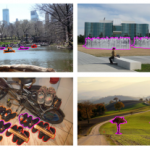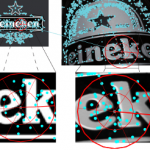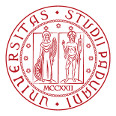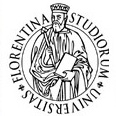University of Florence
Course on Multimedia Databases – 2013/14 (Prof. A. Del Bimbo)
Instructors: Lamberto Ballan and Lorenzo Seidenari

Goal
The goal of this laboratory is to get basic practical experience with image classification. We will implement a system based on bag-of-visual-words image representation and will apply it to the classification of four image classes: airplanes, cars, faces, and motorbikes.
We will follow the three steps:
- Load pre-computed image features, construct visual dictionary, quantize features
- Represent images by histograms of quantized features
- Classify images with Nearest Neighbor / SVM classifiers
Getting started
- Download excercises-description.pdf
- Download lab-bow.zip (type the password given in class to uncompress the file) including the Matlab code
- Download 4_ObjectCategories.zip including images and precomputed SIFT features; uncompress this file in lab-bow/img
- Download 15_ObjectCategories.zip including images and precomputed SIFT features; uncompress this file in lab-bow/img
- Start Matlab in the directory lab-bow/matlab and run exercises.m

MICC laboratories, Florence, 31th October 2013 (10.15-13.15). Course on Multimedia Databases (DBMM) – laboratory lecture.
- Goal: logo recognition in web images.
- Dataset/testset: find 4 different logos vs 110 images.
- Evaluation metrics: recognition performances will be evaluated in terms of mean Average Precision (mAP).
Instructors: Lamberto Ballan, Lorenzo Seidenari.
Download Software & Dataset  (* based on VLFeat library by A. Vedaldi)
(* based on VLFeat library by A. Vedaldi)
Final results (ranking): http://goo.gl/o5DCG5
 Our paper “Copy-Move Forgery Detection and Localization by Means of Robust Clustering with J-Linkage” by I. Amerini, L. Ballan, R. Caldelli, A. Del Bimbo, L. Del Tongo, and G. Serra, has been accepted for publication by the Signal Processing: Image Communication journal (pdf, link); more info on this page.
Our paper “Copy-Move Forgery Detection and Localization by Means of Robust Clustering with J-Linkage” by I. Amerini, L. Ballan, R. Caldelli, A. Del Bimbo, L. Del Tongo, and G. Serra, has been accepted for publication by the Signal Processing: Image Communication journal (pdf, link); more info on this page.
Understanding if a digital image is authentic or not, is a key purpose of image forensics. There are several different tampering attacks but, surely, one of the most common and immediate one is copy-move. A recent and effective approach for detecting copy-move forgeries is to use local visual features such as SIFT. Often, this procedure could be unsatisfactory, in particular in those cases in which the copied patch contains pixels that are spatially distant, and when the pasted area is near to the original source. In such cases, a better estimation of the cloned area is necessary in order to obtain an accurate forgery localization. We present a novel approach for copy-move forgery detection and localization based on J-Linkage which performs a robust clustering in the space of the geometric transformation.
 Our paper entitled “Context-Dependent Logo Matching and Recognition” – by H. Sahbi, L. Ballan, G. Serra and A. Del Bimbo – has been accepted for publication in the IEEE Transactions on Image Processing (pdf, link). Part of this work was conducted while me and G. Serra were visiting scholars at Telecom ParisTech (in spring 2010).
Our paper entitled “Context-Dependent Logo Matching and Recognition” – by H. Sahbi, L. Ballan, G. Serra and A. Del Bimbo – has been accepted for publication in the IEEE Transactions on Image Processing (pdf, link). Part of this work was conducted while me and G. Serra were visiting scholars at Telecom ParisTech (in spring 2010).
We contribute through this paper to the design of a novel variational framework able to match and recognize multiple instances of multiple reference logos in image archives. Reference logos as well as test images, are seen as constellations of local features (interest points, regions, etc.) and matched by minimizing an energy function mixing (i) a fidelity term that measures the quality of feature matching (ii) a neighborhood criterion which captures feature co-occurrence/geometry and (iii) a regularization term that controls the smoothness of the matching solution. We also introduce a detection/recognition procedure and we study its theoretical consistency. We show the validity of our method through extensive experiments on the novel challenging MICC-Logos dataset overtaking, by 20%, baseline as well as state-of-the-art matching/recognition procedures. We present also results on another public dataset, the FlickrLogos-27 image collection, to demonstrate the generality of our method.

The paper “A SIFT-based forensic method for copy-move attack detection and transformation recovery” by I. Amerini, L. Ballan, R. Caldelli, A. Del Bimbo, and G. Serra is now officially accepted for publication by the IEEE Transactions on Information Forensics and Security.
One of the principal problems in image forensics is determining if a particular image is authentic or not. This can be a crucial task when images are used as basic evidence to influence judgment like, for example, in a court of law. To carry out such forensic analysis, various technological instruments have been developed in the literature.
In this paper the problem of detecting if an image has been forged is investigated; in particular, attention has been paid to the case in which an area of an image is copied and then pasted onto another zone to create a duplication or to cancel something that was awkward. Generally, to adapt the image patch to the new context a geometric transformation is needed. To detect such modifications, a novel methodology based on Scale Invariant Features Transform (SIFT) is proposed. Such a method allows both to understand if a copy-move attack has occurred and, furthermore, to recover the geometric transformation used to perform cloning. Extensive experimental results are presented to confirm that the technique is able to precisely individuate the altered area and, in addition, to estimate the geometric transformation parameters with high reliability. The method also deals with multiple cloning.
More information about this project (there are also links to datasets used in the experiments) are available on this page.

I have submitted my PhD thesis: “Object and event recognition in multimedia archives using local visual features” (supervisors: Prof. Alberto Del Bimbo and Dr. Marco Bertini). The dissertation will be defended on April 21, 2011. The thesis committee is comprised of three members: Prof. Enrico Vicario (Univ. of Florence, ING-INF/05), Prof. Giuliano Benelli (Univ. of Siena, ING-INF/04), Prof. Marco Scarpa (Univ. of Messina, INF/01).
“The digital revolution has converted old, analog technologies into a digital format. In this context, due to the widespread availability of personal and professional imaging devices, the low cost of multimedia storage and ease of content transmission and sharing, the need to automatically analyze and organize large amounts of visual data becomes more and more prominent. But although data processing capabilities of machines are truly impressive if compared to a human, data interpretation skills are very poor. It is mainly due to the fact that machines can only compute low level properties of data that have no clear relation with high level conceptual semantics. We present in this thesis a step-by-step methodology to reduce this semantic gap and to achieve automatic annotation and retrieval of visual content. This task may consist of determining whether the visual data contains some specific property, object or activity. […]”
I report in this page also the latex template used for my thesis at MICC (now it is the standard in our lab) and a zip file with the cover template (useful to produce a cool book in 17×24 format).

MICC laboratories, Florence, 21st October 2009 (10.30-13.30). Course on Multimedia Databases (DBMM) – laboratory lecture.
- Goal: logo recognition in web images.
- Dataset/testset: find 2 different logos vs 100 images.
- Evaluation metrics: recognition performances will be evaluated in terms of Precision and Recall.
Tutors: Lamberto Ballan, Lorenzo Seidenari.
Download slides  (with references) | Download Software & Dataset
(with references) | Download Software & Dataset 









